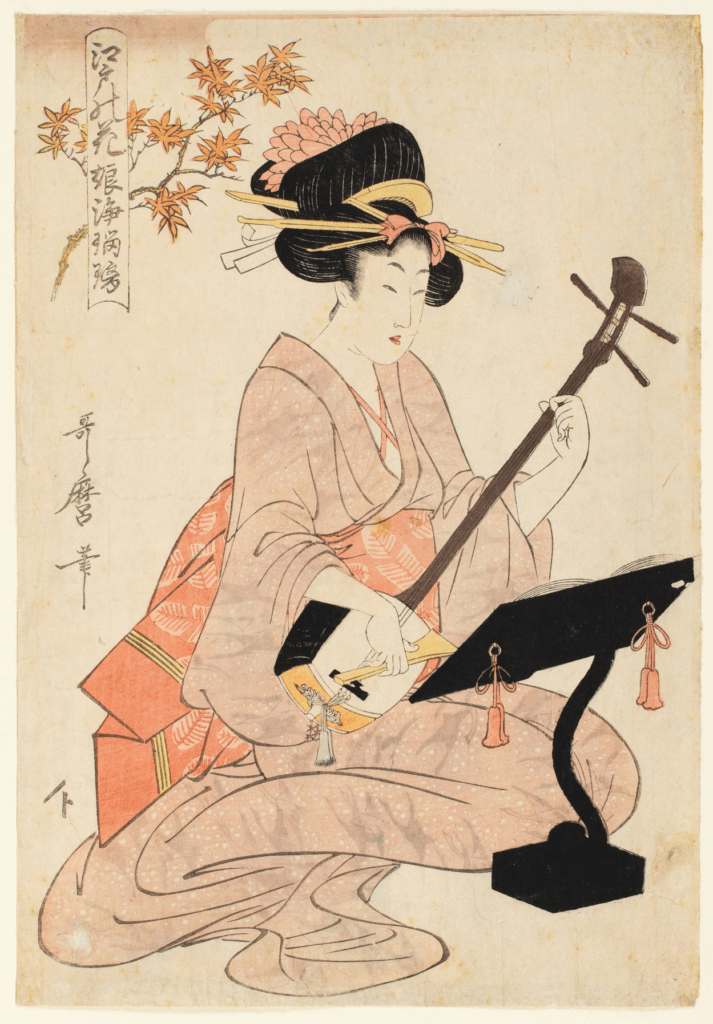Screening at the fifth edition of IN-EDIT NL will be Yuji Moriwaki’s Bring Minyo Back. The film looks at the Minyo Crusaders, a Tokyo-based band looking to bring the genre back from oblivion. But what exactly is Japanese Minyo? We thought we’d dive a bit deeper into the genre.
Japanese Minyo (Min’yō) music is a vibrant and essential part of the country’s cultural identity, with a history spanning centuries. This genre evolved through generations of musicians, each bringing unique styles and sounds. What makes Minyo music so distinct is the use of traditional Japanese instruments, such as the shamisen, taiko drums, shakuhachi, and koto, and the high-pitched, nasal style known as hayanagata used in the vocals.

Minyo music has its roots in the Heian period (794-1185), where music played an important role in court ceremonies and religious events. The music was performed by professional musicians, and only the aristocracy could enjoy it. The music scene changed during the Edo period (1603-1868) when the travelling musicians, known as komuso, began to spread the music to new audiences. They would travel from town to town, performing Minyo music in the streets.
As Minyo music became more accessible to the common people, regional variations started emerging. Each region had its unique style and instrumentation, reflecting the local culture and traditions. For example, the music from Okinawa, a small island in the south of Japan, is known for using the sanshin. This three-stringed instrument resembles the shamisen. The Okinawan style of Minyo (Ryukyu) is slower and more melodic than other forms.
Minyo music experienced a resurgence in popularity during the 1960s when China Sadao, born in Okinawa, became one of the most prominent artists in the genre. He played the shamisen and sang in the traditional Ryukyu Minyo style, blending it with elements of modern music to create a distinctive sound that appealed to younger audiences. China’s popularity helped to bring Minyo to a broader audience, and other artists started incorporating it into their work.
The aforementioned Minyo Crusaders are a modern-day group turning heads with their innovative approach to the genre. Blending Minyo music with elements of Latin, Afrobeat, and other global styles. Their album Echoes of Japan celebrates Minyo’s roots, reimagined through a modern lens. The Minyo Crusaders have brought their unique sound and that of traditional Japanese music across the world, including a 2022 performance at The Netherlands’ Lowlands Festival.
Los Angeles’ Minyo Station is another contemoprary group with their own unique take on the genre. Minyo Station’s mission is to not only embrace the roots of traditional Japanese music. Their unique blend of Minyo with contemporary jazz features traditionally trained vocals and instrumentation combined with western instruments.
Minyo has also found its way into many Western, or Western-adjacent, artists’ work with influences felt across a wide range of musicians and genres. Bjork, John Zorn, Steve Reich, Ryuichi Sakamoto, and Joji Hirota are examples of musicians who have blended Minyo with modern jazz, rock, classical, and popular music to create a unique sound that reflects the rich and diverse cultural heritage of Japan.
When it comes to Minyo’s most famous songs, Sakura Sakura is a classic that dates back to the Edo period. This traditional Japanese folk song is played during cherry blossom season. Kokiriko Bushi is another popular song with its upbeat tempo and catchy melody. Typically performed with a group of dancers using wooden clappers to keep time with the music. And then there’s Furusato, a sentimental ode to one’s birthplace. The lyrics express a deep nostalgia and longing for the place where one was born and raised. Many artists have covered the song over the years, and it remains a favourite among Minyo fans.
The popularity of Minyo music is also evident in the world of video games. For example, the popular game Ōkami soundtrack features traditional Japanese music, including Minyo elements. The well-received game’s creators wanted to immerse players in the world of ancient Japan, and Minyo music was a crucial part of achieving this goal.
Then there is the Gion Matsuri festival has been held for over a thousand years and features various traditional Japanese folk music and dance performances. The Gion Matsuri is not solely a folk music festival. Still, it is an example of a festival incorporating traditional Japanese folk music into its celebrations. It is a significant cultural event that has been passed down through generations.
Despite its long history and enduring popularity, Minyo music faces challenges in the modern era. The rise of pop music and other genres has led to a decline in interest in traditional music among younger generations. However, there are also reasons for optimism. The Minyo Crusaders and other modern-day groups are introducing the genre to new audiences worldwide, and festivals like the Gion Matsuri continue to celebrate its rich heritage. In addition, there are efforts to introduce Minyo music into schools and educational programs, ensuring that future generations can appreciate this vital part of Japan’s cultural identity.
Featured Image: Sawai Susao, CC BY-SA 2.0 <https://creativecommons.org/licenses/by-sa/2.0>, via Wikimedia Commons




